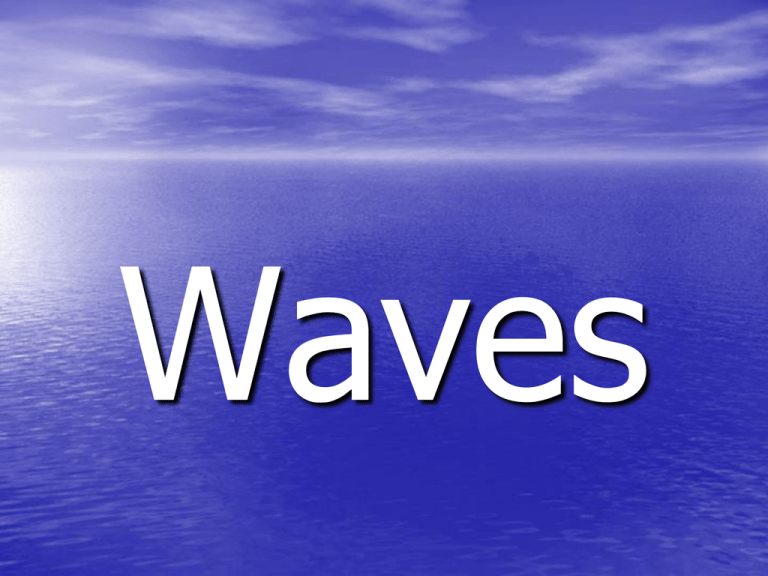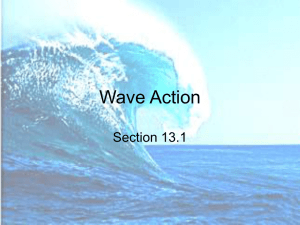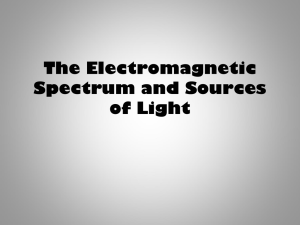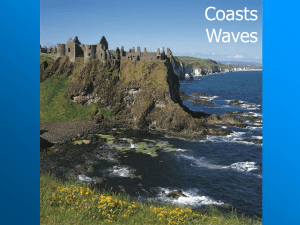Waves Power Point
advertisement

Waves What is a wave? • A repeating disturbance or movement that • • transfers energy through matter or space Waves transfer energy not matter. Waves can only exist as they have energy to carry. – The water waves to the right are carrying energy but are not moving. What are mechanical waves? • They require a medium. – A medium is a form of matter (a substance or material) through which the wave travels and it can be a solid, liquid or gas. • They are not capable of transmitting its energy through a vacuum (empty space), such as light from the sun What are mechanical waves? • They are produced when a source of energy causes a medium to vibrate. – Vibration is a repeated back and forth or up and down motion • There are two types of mechanical waves based on how the wave moves: – Transverse Waves – Longitudinal Waves Transverse Waves • The matter vibrates perpendicular (at right angles) to the direction of the wave – Electromagnetic waves and light waves Animation courtesy of Dr. Dan Russell, Kettering University Transverse Wave Properties • The crest is the highest point • The trough is the lowest point • The rest position is the horizontal line representing the rope (medium) before it was disturbed. • The wavelength is the distance from one point on the wave to the next corresponding adjacent point, such as crest to crest or trough to tough Longitudinal Wave • The matter vibrates parallel (same) to the direction of the wave – sound waves Animation courtesy of Dr. Dan Russell, Kettering University Longitudinal Wave Properties • The area squeezed together is called compressions like the crests on a transverse wave – In the picture, where the parts of the medium (coils of the Slinky) are closer together than normal • The areas spread out are called rarefactions like the troughs on a transverse wave – In the picture, where the parts of the medium are farther apart than normal Sound Waves • Sound is a longitudinal • wave which travels through the air through a series of compressions and rarefactions. Sound travels through air, but travels through other materials as well. What is echolocation? What is sonar? • Sonar is a system that uses the reflection of underwater sound waves to detect objects. This has been used to find sunken ships and schools of fish. What are seismic waves? • An energy wave which vibrates through the earth’s crust as the crust bends or breaks. • Seismic waves exist as transverse (secondary waves), longitudinal (primary waves) and both types (surface) of waves. • Some travel through the earth (P and S waves) and some travel across the earth’s surface (surface waves). Animation courtesy of Dr. Dan Russell, Kettering University Surface Waves • A combination of longitudinal & transverse Animation courtesy of Dr. Dan Russell, Kettering University Amplitude • The amplitude of a wave is directly related to the energy of a wave. • The amplitude of a longitudinal wave is determined by the closeness of the compressions. The closer the compressions and the farther the rarefaction lines. • The amplitude of a transverse wave is determined by the height of the crest or depth of the trough. Wavelength and Frequency • Wavelength is the distance between two corresponding • parts of a wave. Transverse wave: a measure of distance from crest to crest or trough to trough • Longitudinal wave: a measure of the distance between one compression and rarefaction to the next • Frequency is the number of waves that pass through a point in a certain amount of time. – The unit for frequency is waves per second or Hertz (Hz). – One Hz = One wave per second. Wavelength and Frequency • Wavelength and frequency are inversely related. • A decrease in the wavelength, means the more times the wave will pass through a point in one second (an increased frequency). • The larger the wavelength (or increased wavelength), the fewer times it will pass through a point in one second (a decreased frequency). Electromagnetic Waves • Wave which is capable of transmitting its energy through a vacuum (i.e., empty space) • Produced by the vibration of electrons within • atoms on the Sun's surface Travel through space until they reach Earth







